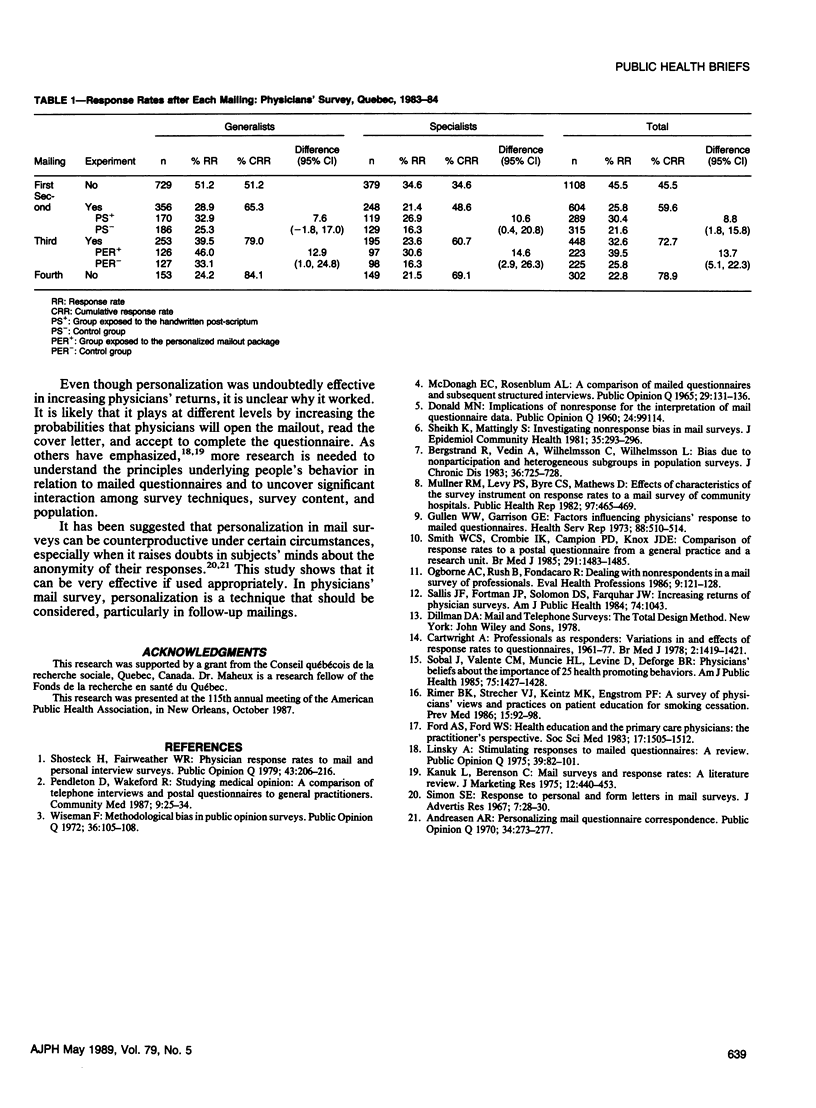Abstract
It is becoming increasingly difficult to obtain high response rates in physicians' mail surveys. In 1983-84, we tested the effectiveness of two techniques among 604 Quebec physicians who had not responded to an initial letter. A handwritten thank you note at the bottom of the letter accompanying the questionnaire and a more personalized mailout package increased response rates by 40.7 per cent and 53.1 per cent, respectively, compared to control groups.
Full text
PDF

Selected References
These references are in PubMed. This may not be the complete list of references from this article.
- Bergstrand R., Vedin A., Wilhelmsson C., Wilhelmsen L. Bias due to non-participation and heterogenous sub-groups in population surveys. J Chronic Dis. 1983;36(10):725–728. doi: 10.1016/0021-9681(83)90166-2. [DOI] [PubMed] [Google Scholar]
- Cartwright A. Professionals as responders: variations in and effects of response rates to questionnaires, 1961-77. Br Med J. 1978 Nov 18;2(6149):1419–1421. doi: 10.1136/bmj.2.6149.1419. [DOI] [PMC free article] [PubMed] [Google Scholar]
- Ford A. S., Ford W. S. Health Education and the primary care physician: the practitioner's perspective. Soc Sci Med. 1983;17(20):1505–1512. doi: 10.1016/0277-9536(83)90095-3. [DOI] [PubMed] [Google Scholar]
- Gullen W. H., Garrison G. E. Factors influencing physicians' response to mailed questionnaires. Health Serv Rep. 1973 Jun-Jul;88(6):510–514. [PMC free article] [PubMed] [Google Scholar]
- Mullner R. M., Levy P. S., Byre C. S., Matthews D. Effects of characteristics of the survey instrument on response rates to a mail survey of community hospitals. Public Health Rep. 1982 Sep-Oct;97(5):465–469. [PMC free article] [PubMed] [Google Scholar]
- Pendleton D., Wakeford R. Studying medical opinion: a comparison of telephone interviews and postal questionnaires to general practitioners. Community Med. 1987 Feb;9(1):25–34. doi: 10.1093/oxfordjournals.pubmed.a043903. [DOI] [PubMed] [Google Scholar]
- Rimer B. K., Strecher V. J., Keintz M. K., Engstrom P. F. A survey of physicians' views and practices on patient education for smoking cessation. Prev Med. 1986 Jan;15(1):92–98. doi: 10.1016/0091-7435(86)90039-3. [DOI] [PubMed] [Google Scholar]
- Sallis J. F., Fortmann S. P., Solomon D. S., Farquhar J. W. Increasing returns of physician surveys. Am J Public Health. 1984 Sep;74(9):1043–1043. doi: 10.2105/ajph.74.9.1043. [DOI] [PMC free article] [PubMed] [Google Scholar]
- Sheikh K., Mattingly S. Investigating non-response bias in mail surveys. J Epidemiol Community Health. 1981 Dec;35(4):293–296. doi: 10.1136/jech.35.4.293. [DOI] [PMC free article] [PubMed] [Google Scholar]
- Shosteck H., Fairweather W. R. Physician response rates to mail and personal interview surveys. Public Opin Q. 1979 Summer;43(2):206–217. doi: 10.1086/268512. [DOI] [PubMed] [Google Scholar]
- Smith W. C., Crombie I. K., Campion P. D., Knox J. D. Comparison of response rates to a postal questionnaire from a general practice and a research unit. Br Med J (Clin Res Ed) 1985 Nov 23;291(6507):1483–1485. doi: 10.1136/bmj.291.6507.1483. [DOI] [PMC free article] [PubMed] [Google Scholar]
- Sobal J., Valente C. M., Muncie H. L., Jr, Levine D. M., Deforge B. R. Physicians' beliefs about the importance of 25 health promoting behaviors. Am J Public Health. 1985 Dec;75(12):1427–1428. doi: 10.2105/ajph.75.12.1427. [DOI] [PMC free article] [PubMed] [Google Scholar]


